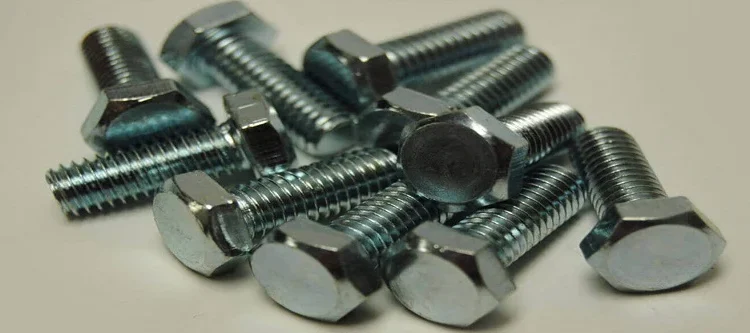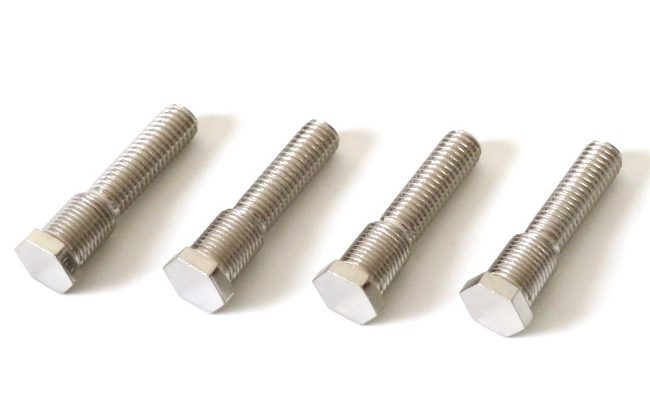
5 Key Factors In Specifying Bolts
Size, material, strength grade, thread type, and coating are key factors in specifying bolts. Example: M12x1.75, Grade 8, zinc-plated stainless steel.
Sizes And Dimensions
Item Dimension and size are vital in the selection of bolts for their application and they must be of the right size to fit to the adjoining parts. Here’s a detailed look:
Diameter
Bolt Diameter Your bolt diameter is an important spec. Measured in inches, using the imperial system, or millimeters, using the metric system. For instance, a 12mm diameter bolt is frequently labeled M12. One example of such a lug is the 1/2-inch bolt used in the imperial system. And the diameter specs are crucial for matching the hardware to the nuts and predrilled holes.
Length
Another important dimension is the Length of the bolt. It is measured from the bottom of the head to the end of the bolt. Ranges of length from 20mm to over 200mm are possible in metric sizes. For example, an M12 bolt may have measurements listed as M12x80, meaning an 80mm length. Even more Imperial-length common; 1in, 2in, etc; Choosing the length of the bolt means that the bolt will dependably bolt the material that it is intended to bolt.
Thread Pitch
Thread pitch = how close or far apart the threads are on the bolt. This is measured in millimeters between the threads for metric bolts. For example, an M12x1. 75 is 1.75mm thread pitch. The pitch also may be used to identify one-piece pulleys, while the number of threads per inch (TPI) represents the pitch in the imperial system. 18 TPI is a common thread pitch. Precision thread pitch ensures a secure fastening within the nut or threaded hole.
Head Size
A bolt may have a number of different types of head depending on how it is to be used and the design. A few standard styles are hex heads, socket heads and countersunk heads. An M12 hex bolt has a head size of 19 across the flats. The size falls within the range used by regular tools such as wrenches and sockets. Selecting the Correct Head Size: The diameter of the head size: A necessary measure when installing and taking up.
Tolerances
Bolt sizes have tolerances related to their manufacturing allowing to be used in the limits. Such tolerance classes are defined in ISO 965-1 (for metric bolts) and ASME B1. 1 for imperial bolts. E.g., the M12 cap screws might vary between ±0.15mm for their diameter. Knowledge and adhering to these tolerances are required to obtain bolts that deliver the performance and reliability they were designed for.

Material Selection
Selecting the proper material for bolts is one of the most important considerations to make sure they meet the demands of their usage. Here’s a detailed look:
Carbon Steel
The most widely used material for bolts, the carbon steel makes up to the increased cost and physical characteristics of the bolt. Carbon steel bolts are commonly identified by their grade which indicates the carbon content of the bolt and tensile strength. For example, tensile strength of Grade 5 bolts is equal to 120,000 psi, while that of Grade 8 bolts is 150,000 psi. General-purpose, high-strength carbon steel bolts.
Stainless Steel
G Stainless Steel Bolts G Stainless steel bolts have excellent corrosion resistance, making them ideal for higher than normal water exposure or aggressive chemicals. Grades such as 304 and 316 stainless steel are Examples of common grades. The common grades are 304 stainless steel which provides an excellent balance of corrosion resistance and strength over a wide range of temperatures and environments. 316 stainless steel quite similar grade to 304, particularly it has a higher nickel content which help to improve the corrosion resistance (especially to pitting and crevice corrosion in chloride environments). The improved corrosion resistance of 316 stainless steel bolts make them common in saltwater applications.
Alloy Steel
The alloy steel bolts are made of steel with another elements such as chromium, molybdenum, and nickel added to change its mechanical properties. These bolts are also heat-treated to produce a high tensile strength and hardness. The higher tensile strength of ASTM A193 Grade B7 bolts make them well suited for use in high-temperature and high-pressure applications, such as in the petroleum industry. Between the two of them, alloy steel bolts are best suited to the most demanding environments and conditions, calling for maximum strength and durability.
Brass
Brass bolts have good electrical conductivity and do not corrode easily. Applications which require electrical conduction where corrosion resistance is necessary. In contrast to steel, brass bolts are soft, so they are generally used to provide superior traction as easy to use bolts. Since they are non magnetic and have great resistance to corrosion, brass bolts are usually used in plumbing or electrical applications.
Titanium
Pros: Very strong for the weight, corrosion resistance. They offer aerospace, medical and high-performance automotive end-users. For instance, Grade 5 titanium bolts (aka Ti-6Al-4V) offer a 130,000 psi tensile strength, but are literally 40% the weight of a comparably sized stainless steel bolt. Weight savings, Corrosion resistant applications being necessary, Titanium bolts.
Strength Grades
Bolt Strength GradesThere are different grades of bolt strength having specific application: Here’s a detailed look:
Grade 2
Grade 2 bolts are made of low or medium carbon steel and are most common in general applications. We are talking about these bolts, which have a tensile strength of around 74,000 psi. They are unmachined and usually used when hardness is not an important part. For household and light construction use, Grade 2 bolts are common.
Grade 5
Type 5 bolts are hardened carbon steel, similar to Type 8 bolts but with an added heat treatment. These are rated at 120,000 psi tensile strength. They are often used in automotive and construction applications when greater strength is required. Grade 5 boltswith three radial lines on their head for easy identification.
Grade 8
A Grade 8 bolt is the strongest of all the grades of carriage bolts and are made from medium carbon alloy steel (manufactured from the same basic iron and carbon materials, but the largest alloy bolts have been heat-treated by a special process to develop a high ultimate tensile strength of 150,000 psi or more). Attaching to heavy machinery, truck suspension systems, and any other type demanding use, these bolts are simply re-installed using the same locking hardware that was already included in the box from McGill Metals. The Grade 8 bolts are marked with six radial lines on the head.
ASTM A325
A325 bolts are heavy hex structural bolts in plain finish or hot dip galventized finish. Diameters up to 1 inch — 120,000 psi diameters greater than 1 inch — 105,000 psi minimum tensile strength. These bolts are used in construction of bridges, buildings etc. In construction ASTM A325 bolts are very necessary for that, it helps to provide the structural integrity of all major construction projects.
ASTM A490
ASTM A490 bolts are heavy-duty steel bolts used in structural steel columns, trusses and beams. Minimum tensile strength is 150,000 psi. These bolts are utilized in high-stress joints where maximum tension and shear strength is required. Types of mechanical bolts that are commonly used for types of work that require a lot of stress, these bolts are known as ASTM A490 bolts and have an impact on the level of safety and stability of a large building.
Thread Types
Certain applications require the use of various thread types to ensure proper engagement, or to prevent fasteners from loosening. Here’s a detailed look:
Coarse Threads
Common 1 1/2″ coarse thread: The UNC (Unified National Coarse) thread. More easily built (far less risk for cross-threading) For example, a 1/2-13 UNC bolt has 13 threads per inch. Applications needing easy assembly & disassembly favor coarse threads.
Fine Threads
Using a fine thread, or Unified National Fine (UNF) thread, provides better tension and tightening than the coarse thread. Application 13 They Are Used In The Application Where Need A stronger Tighter fonts Another example, 1/2-20 UNF has 20 threads per inch. Fine threads are often applied where high-precision is desired, including automotive and aerospace industries.
Metric Threads
Metric threads are named in terms of the pitch in millimeters. For example, an M10x1. 10mm diameter and 1.5mm-thread pitch (5 bolt) ISO Metric Thread Standard: The ISO Metric Thread Standard is the most widely used thread form in the world. Metric threads are imperative for global compatibility and are applied in different sectors worldwide
Acme Threads
Acme threads are trapezoidal threads that are larger than the Vs but are also quicker threaded. They are used for the high strength and power transmission applications like lead screws and heavy machinery. Because the Thread Profile has a greater surface contact area, it distributes loads over a wider area and does not have any sharp roots to create stress risers. Applications where high force and heavy loads are significant require acme threads.
Buttress Threads
Buttress threads are made to withstand large axial forces but in only one direction. Usually found in Hydraulic presses & jacks Its flat face on one side and angled side on the other side are a unique thread profile that gives the highest strength in the load direction. Buttress threaded applications are required for the purpose of providing a high degree direction force handling.

Coatings And Treatments
Bolt coatings and treatments help integrate bolt strength and corrosion resistance, hardness, and overall service life. Here’s a detailed look:
Zinc Plating
Many bolts have a coating of zinc plating to protect against corrosion. It is a method of electroplating a thin layer of zinc on the surface of the bolt. Zinc-Plated Bolts: best used in environments with less of a need for corrosion protection. This is the case, for example, with zinc plating protecting up to 72 hours of corrosion resistance when exposed to salt spray tests. The use of zinc-plated bolts is best done for indoor use and where moisture exposure is infrequent, generally accepted as general use.
Hot-Dip Galvanizing
The process of hot-dip galvanizing is when bolts are placed in molten zinc, It forms a very heavy coating that is durable. This process offers better corrosion protection than with zinc plating. They resist 1000 hrs in salt spray testing, which is a good solution for not only outdoor but also industrial usages. Hot dip galvanized bolts are vital for areas as extreme climates as they withstand structural and other kinds of tensile loads.
Black Oxide
Black oxide is a conversion coating providing minimal corrosion resistance and an appealing black finish. This is done by immersing the bolts in an alkaline solution to generate a thin layer of magnetite on the surface. These shorter black oxide bolts are used in applications where looks are important and moderate corrosion resistance is desired. Black oxide is a traditional finish used in the automotive and machinery markets due to its attractive and durable properties.
Cadmium Plating
This plating also provides the highest levels of corrosion resistance and lubricity, features that are particularly valuable in the aerospace and marine industries. The technique mechanically deposits a layer of cadmium on the surface of the bolt. In salt spray tests, cadmium-plated bolts can last for as long as 1000 hours without showing any sign of corrosion. Cadmium plating is highly recommended for those applications that require maximum corrosion resistance and minimal friction.
Phosphate Coating
Phosphate Coating or otherwise known as Phosphating is the application of rich crystalline phosphate layer to the surface of a bolt. This treatment also imparts corrosion protection and a base for painting or lubrication. These products are routinely utilized for the manufacture of various automotive and mechanical support systems and are frequently related to phosphate-coated bolts. With phosphate coatings, paint adhesion is increased as well as some corrosion protection.



